[NGW Magazine] Energy Transition: is Sky the Answer?
There has been no shortage of commentary on the impossibility of painlessly achieving the Paris Agreement goals without making heroic assumptions. Now Shell is having a go in its Sky scenario, but carbon capture and storage is still under a big question-mark.
The world is going through a major and permanent transition from high-carbon to low-carbon energy, with a relentless increase in the use of renewables at the expense of fossil fuels. This is happening at a time of rising energy demand, especially in Asia and Africa, in response to rising populations and higher standards of living in these continents.
There is a general consensus about the need to achieve the 2015 Paris Agreement goals in the longer term, but getting there is not without its challenges.
Ensuring a smooth transition over the next 20 to 30 years means having sufficient and affordable energy for the world’s needs, while embarking on a pathway from a high to a low carbon future, with the aim to permanently reduce emission levels.But a key issue is how to achieve the Paris goals without major disruption and unexpected consequences.
It is becoming clear that the nationally determined contributions (NDC)-based energy transition policies will not achieve the Paris Agreement 2°C goal (Figure 1). Most countries are failing on their pledges. In order to succeed in that, policies must be accelerated dramatically and globally. But is this mission impossible?
Figure 1: Mission impossible?
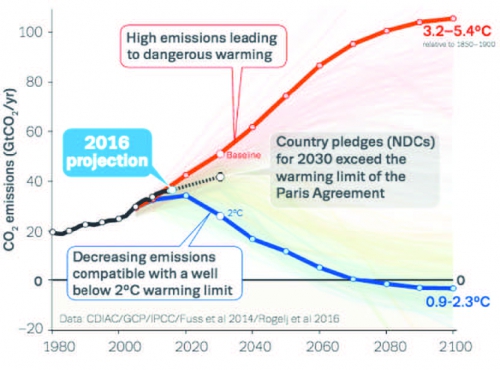
Source: Carbon Brief
For example, if such accelerated change is not implemented fully by all, including China and India, coal consumption in Asia by 2040 will still be at 2012 levels, despite Paris Agreement pledges. So far in Asia and Africa, economic drivers often mean that ‘cheaper beats cleaner’, except perhaps in major cities where clean air matters.
Affordable energy is key. Denmark has achieved the highest implementation of renewables in Europe in power generation and by 2022 this is expected to reach 70%. But this has been at a cost. Denmark’s electricity prices are the highest in Europe, followed by Germany, which is also investing heavily in renewables, at the expense of gas-fired generation. Copying this lifestyle is not possible in much of Asia and Africa, where costs really matter.
But there is hope. Spurred by innovation, increased competition, and policy support in a growing number of countries, renewable energy technologies have achieved massive technological advances and sharp cost reductions and they will continue doing so. But even here there are challenges.
International Energy Agency’s (IEA) new Tracking Clean Energy Progress report, released in May, shows that only 4 out of 38 technologies and sectors are on track to meet climate goals. For example, energy efficiency improvements have slowed and progress on key technologies like carbon capture and storage remain stalled.
In addition, the fossil fuel industry is not making it any easier. Technological improvements and improved working practices and productivity are producing massive cost reductions, making fossil fuels even more competitive and reliable, delaying transition. Examples here can be seen in the shale oil and gas revolutions and the advance of digitalisation and automation.
Last year was a rude awakening. After stalling for three years, global carbon emissions increased by 1.4%, when energy demand rose 2.3%, and energy supply has not become cleaner over time. So far, despite the rapid increase in renewables, the deployment of low-carbon energy has not kept up with energy demand growth. These outcomes show that the world has some way to go before it reaches the point of continuous decline in carbon emissions and tackles the already monumental challenge ahead.
Global energy demand
Based on BP’s Global Energy Outlook 2018, in 2016 85% of global primary energy was supplied by fossil fuels, with only 3% by renewables, sun and wind.
All else being equal, by 2040 global primary energy is expected to go up by about 35%, in line with population growth of 1.7bn, reaching 9.2bn, and with 2.5bn people to be lifted out of poverty as emerging economies prosper.
This is based on an average world GDP growth of 3.25% and assuming that government policies, technology and social preferences continue to evolve in a manner and speed seen over the recent past, with renewables continuing to grow fast. BP called this the Evolving Transition (ET) scenario (Figure 2). Based on this, carbon emissions are expected to actually increase by 14% by 2040.
Figure 2: BP-Global energy and carbon emissions
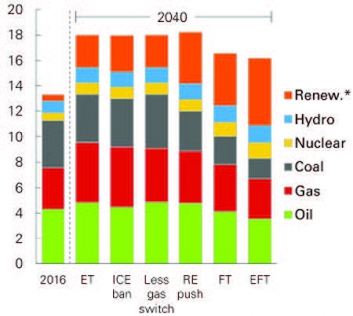
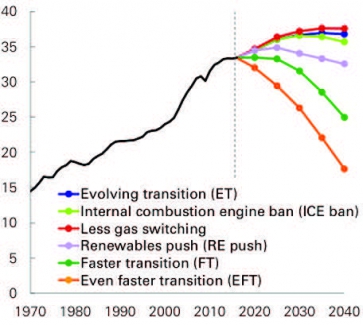
Source: 2018 BP Energy Outlook
In order to achieve emission reductions commensurate with the 2°C target, the world needs to move into what BP calls the ‘even faster transition’ (EFT) scenario. This is one possible configuration of policies and outcomes achieving a break with the past. It is based on a sharp increase in carbon prices and a range of polices designed to encourage more rapid gains in energy efficiency and greater fuel switching.
This is similar to the IEA ‘sustainable development scenario’ and other such scenarios proposed by other organisations to keep global temperature rises below 2°C.
In this, renewables provide about a third of global primary energy by 2040, but fossil fuels still provide 50% of world energy needs.
Even the International Renewable Energy Agency (Irena), which advocates green policies, admits that without accelerated measures the 2°C target cannot be achieved, with the energy-related carbon budget exhausted in less than 20 years. Irena proposes a 'renewable energy roadmap' (Remap).
That assumes that total primary energy supply remains unchanged to 2050 through energy efficiency measures, and wider deployment of low carbon technologies, including renewables, hydro and nuclear, provide 66% of global primary energy needs. But even then, fossil fuels are expected to provide the remaining 34% (Figure 3).
Figure 3: Irena – Global energy and carbon emissions
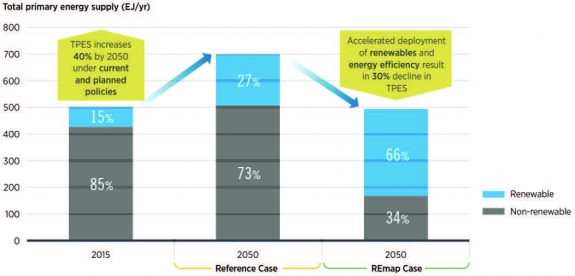
Source: Irena
Challenges
These accelerated scenarios, whether as proposed by BP, or the IEA or Irena and others, require drastic emission reduction policies to be accepted, to be enforceable, and to be implemented immediately and globally. According to Irena, a six-fold increase in the rate of implementation of renewables will be needed, to contribute 65% of total final energy consumption by 2050, while at the same time achieving substantial improvements in energy efficiency (Figure 4). And there lies the challenge.
Figure 4: Renewables, improved energy effi ciency can reduce CO2 emissions to achieve Paris Agreement goals
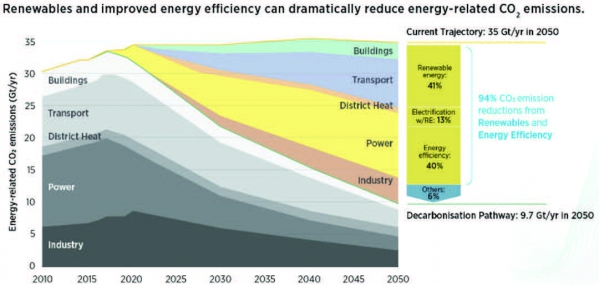
Source: Irena
So far implementation of the Paris Agreement has had variable, but mostly limited, success, thanks to the NDCs, which will not keep global temperature rise to less than 2°C.
This is reflected in BP’s evolving transition scenario and Irena’s Reference Case which take into account the current and planned policies of countries. They include NDCs and other planned targets and present a ‘business-as-usual’ perspective, based on governments’ current projections and energy plans. Both lead to similar results and will need new accelerated and enforceable policies to reach the goal.
Is the world ready to embark into another round of negotiations and accept the required drastic emission reduction policies? This is very doubtful and it is by no means clear that the world is ready to act as quickly as it could or should.
A world of clean, reliable, and safe energy is not around the corner and full decarbonisation by 2050 will cost trillions of dollars – there is no cheap option. Investment in renewables so far has been strong, but way below what is needed to achieve targets.
The Bonn meeting in May could not even agree on the $100bn pledged to poorer countries to assist them with implementation of the Paris Agreement (NGW Magazine, Vol.3/10, pp15-17). Where are the trillions going to come from? One source is the oil companies, provided transition is smooth and over a period allowing them to adapt. And the signs are there already.
Energy transition
A fundamental message emerging from IEA analysis is that the world needs an integrated technology and policy approach to drive and accelerate clean energy transitions.
For example, the recent declines in upstream fossil fuel investment illustrate the need for policy co-ordination. Although this change in itself may align with a low-carbon pathway, continued decreases in supply-side investment without commensurate measures to address rising energy demand create significant risks for energy security. As a second example, policies driving electrification can produce greater environmental benefits if implemented alongside ones to decarbonise electricity supply.
Applying such an integrated policy approach requires significant national co-ordination and capacity, including domestic technology and state policy. One such success is the increasing adoption of carbon pricing mechanisms, including China. As the UK has shown, this can be made to work.
And so is energy efficiency. DNV GL has no doubt that energy efficiency is the star player in the line-up driving the energy transition. DNV GL’s Energy Transition Outlook shows that the world’s annual efficiency gains playing a greater role in helping to cut emissions over the coming two decades than the combined contribution of the switch to wind, solar and electric vehicles.
DNV GL forecasts that energy efficiency gains during transition will lead to flattening of world primary energy demand in the 2020s and gradual decline beyond 2030. An annual average 2.5% improvement in the world’s energy intensity could reduce overall energy-related CO2 emissions to around half the present level by 2050. But as the IEA has pointed out, energy efficiency improvements have slowed.
In addition, consultancy DNV GL points out that by themselves such gains are not enough to achieve Paris Agreement goals. This also requires a faster deployment of renewables and implementation of carbon emission reduction policies and technologies.
The power generation sector is also well on the way to being decarbonised, largely because low carbon technology is cheaper than the fossil fuels it replaces. However, intermittency and lack of dispatchability mean that during the transition period fossil fuels will be needed to ensure stable and reliable power supplies.
But clearly, technological advancements and falling costs of low carbon technologies, more than anything else, give cause for optimism about reducing emissions. Over time, as lower-carbon alternatives become cheaper, the case for high carbon technologies will simply disappear. This also guarantees affordability. It will take even longer to decarbonise other sectors, such as transport, heavy industry, petrochemicals, heating. Combustion and process emissions from cement manufacturing, iron- and steelmaking, and chemical production are particularly problematic. As shown earlier, fossil fuels will be needed even by 2050.
This is where IEA’s call for an integrated, co-ordinated, policy approach becomes critical. As IEA’s CEO Fatih Birol said: “The world doesn’t have an energy problem but an emissions problem, and this is where we should focus our efforts.” The various energy transition scenarios proposed by a number of international bodies merit careful consideration. Among these is Shell’s recent Sky scenario.
Shell’s Sky scenario
Earlier this year Shell put forward its Sky scenario, which it claims is a ‘technically possible but challenging pathway’ that can meet Paris Agreement goals. It is not a forecast predicting the future, but a scenario that tests the effect of possible outcomes on the way to net-zero emissions by 2070.
It is an ambitious scenario to hold the increase in the global average temperature to well-below-2°C (Figure 5), based on a rapid energy transition taking place over the next 50 years and often using technologies that are at an early stage. It is also much more ambitious than earlier Shell scenarios, Oceans and Mountains.
Figure 5: Shell’s Sky scenario – impact on global temperature rise
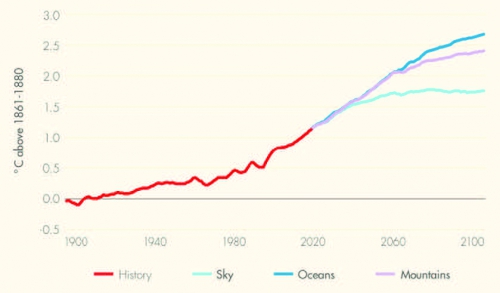
Source: Shell
The Mountains scenario is more government-led with a top- down approach. while Oceans is more bottom-up with a market-driven outcome. Neither achieves Paris Agreement goals. This requires a complex combination of mutually reinforcing drivers being rapidly accelerated by society, markets, and governments. It can be done from now to 2070 by achieving the following:
- A change in consumer mindset means that people preferentially choose low-carbon, high-efficiency options to meet their energy service needs.
- A step-change in the efficiency of energy use leads to gains above historical trends.
- Carbon-pricing mechanisms are adopted by government policies globally over the 2020s, leading to a meaningful cost of CO2 embedded within consumer goods and services.
- The rate of electrification of final energy more than triples, with global electricity generation reaching a level nearly five times today’s level.
- New energy sources grow up to fifty-fold, with primary energy from renewables eclipsing fossil fuels in the 2050s.
- Some 10,000 large carbon capture and storage facilities are built, compared to fewer than 50 in operation in 2020.
- Net-zero deforestation is achieved. In addition, an area the size of Brazil being reforested offers the possibility of limiting warming to 1.5°C, the ultimate ambition of the Paris Agreement.
Sky begins with the structure of economic sectors and government policies and the capacity for change that exists now. For the next ten years it assumes very aggressive, but plausible, capacity-building and ratcheting of policy commitments in line with the Paris Agreement.
Beyond that time-frame, there are great uncertainties about how policies and technology may be developed and implemented globally. So, the scenario progressively becomes driven simply by the ambitious goal to achieve net-zero emissions by 2070 (Figure 6), taking full account of the characteristics of scale, technological substitution, and investment in the various sectors of different national economies.
Figure 6: Progressive impact of Shell’s Sky scenario on global carbon emissions
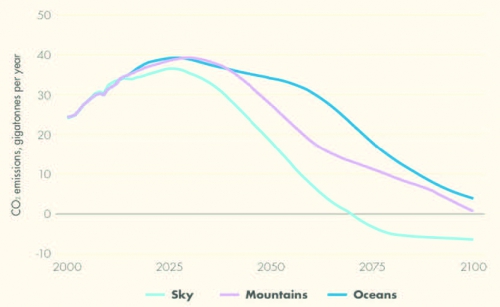
Source: Shell
Sky sees these being achieved through a combination of ‘mutually reinforcing drivers being rapidly accelerated by society, markets and governments.’ It is an approach grounded in the current reality of the energy system, but it is then combined with a specific long-term goal over a reasonable and realistic transition period. Shell uses visual elements to help present what it is proposing (Figure 7). The key words are: peoples’ mindset – energy efficiency – carbon pricing – government policies – electrification – carbon capture and storage – reforestation – technology - net-zero emissions. But, depending on technological developments, by 2050 and even by 2100 the world may still need fossil fuels despite the massive increase in renewables (Figure 8) – the former supply close to 60% of global primary energy by 2050, but this percentage estimate is down to about 30% by 2100.
Figure 7: Illustration of Shell’s Sky scenario by 2050
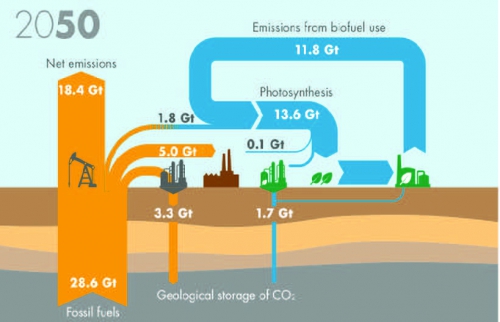
Source: Shell
Figure 8: Impact of Shell’s Sky scenario of global energy sources
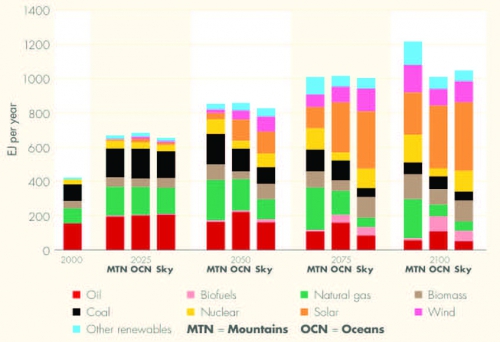
Source: Shell
Global oil demand would peak in 2025 and gas in the 2030s. Gas’ role would be reduced to 12% of primary energy by 2050 and down to 3.5% by 2100, and only if decarbonised. Perhaps unsurprisingly, Shell recognises that ‘a stark reality of the early 21st century is the lack of a clear development pathway for an emerging economy that doesn’t include coal. Coal is a relatively easy resource to tap into and make use of. It requires little technology to get going but offers a great deal, including electricity, heating, industry, and, very importantly, smelting to make iron.’ The Sky scenario would also satisfy the main requirements stated in the introduction to this article: ‘to enable society’s orderly, stable and affordable transition to a low carbon global economy, without major disruption and unexpected consequences.’
One might say that coming from an oil and gas company, the inevitable dependence on fossil fuels is only to be expected. That might be so, but it is a credible scenario, even though very ambitious to achieve. But then, any future scenarios have to be very ambitious to meet climate change goals. Interestingly, Carbon Brief assessed Shell’s Sky scenario and concluded that ‘despite its high energy demand, it is broadly consistent with other well-below-2°C scenarios drawn from academic literature.’ Even Sky’s oil demand is close to the average. In Sky Shell sets out a roadmap for the rest of the century that could help deliver a net-zero emissions system, while still meeting the world's energy access and development goals.
Implications
It is by no means given that that the 2°C goal is achievable. It is becoming clear that current efforts, such as energy efficiency, carbon taxes and renewable energy support, are insufficient. But unless pragmatic and achievable approaches are implemented during a realistic energy transition, it will be that much harder. Change is rapid, introducing uncertainty, making it difficult to define the outcome of energy transition.
But how much can be really achieved? Can country pledges be relied upon? Will society, globally, align itself with the Paris Agreement’s goals? Such questions are by no means easy to answer. The world is dealing with complex global societal systems over an extended period of time involving technology, government policy, and consumer behavior, with the latter driven mostly by quality of life concerns.
Simply repeating the fact that ‘increased ambition is greatly needed and must be accelerated’ is not sufficient. It must also be realistic and achievable. Shell’s SKY scenario offers such a pathway, ‘within techno-economic possibilities’, even if very challenging. Coming from an oil company it is a bold move. Critics, though, argue that it maintains fossil fuel use close to today’s levels well into the future. But Shell responds with a quote from Mahatma Gandhi: ‘the future depends on what we do in the present’.
The biggest challenges are in Asia and Africa. Change can take place if proposed solutions are commercially competitive, help reduce energy costs and contribute to a better quality of life. Reduction of carbon emissions will then be the outcome – it will not be the cause of change.
Charles Ellinas



